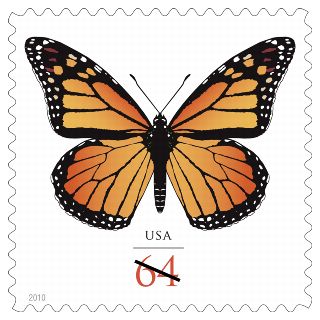
The U.S. Postal Service®, in conjunction with the Greeting Card Association (GCA), announced on December 30, 2009, the first in a new series of postage stamps that will make it simple for greeting card customers to know how much postage to put on their envelopes. The new 64-cent Butterfly stamp is designed to be used on cards that have an irregular shape requiring additional postage. Participating manufacturers will print a silhouette image of a butterfly on their envelopes, making it easy for customers to understand the new butterfly stamp or equivalent postage is all that is needed to mail the card.
The first stamp design in the new series features one of the most recognizable butterflies in North America, the monarch. It will be dedicated at the National Stationery Show held at the Jacob Javits Center in New York on May 17, 2010. The stamp will be published as a pane of 20.
In May 2010, USPS® will offer a new Butterfly stamp, which covers the 1-ounce First-Class Mail® letter postage and the nonmachinable surcharge. The butterfly symbol was chosen as a universal symbol that will be used for all future stamps for nonmachinable letters. When postal prices increase, USPS will issue a new butterfly design for this stamp.
The Butterfly stamp icon carries text that reads: “Butterfly Stamp or Equivalent Postage Required.” This implies that either the Butterfly stamp or postage totaling its value should be used.
The GCA recommends that all square envelopes and those that fall within the nonmachinable letter category carry the Butterfly stamp icon in the upper right-hand corner, thus making it easier for all concerned to determine postage for greeting cards and invitations that fall within the “nonmachinable” specifications.
The United States Postal Service® requires extra postage, called a “nonmachinable surcharge”, on First-Class Mail letters when an envelope:
n Is square or doesn’t meet aspect ratio (length divided by height not within 1.3 to 2.5).
n Is rigid and does not bend easily.
n Contains items that cause the mailpiece to be uneven.
n Has an address that is parallel to the shorter dimension of the letter (vertical setup).
The nonmachinable surcharge is currently 20 cents.
Objectives of the Iconic Stamp Program
To simplify determination of postage for such “nonmachinable” envelopes for both consumers and postal staff, USPS and the GCA have worked in collaboration to develop an iconic stamp program.
The iconic stamp program features:
1. A new postage stamp priced to include both the 1-ounce First-Class Mail letter postage and the nonmachinable surcharge combined with an easily recognizable iconic graphic.
2. A matching iconic graphic that will be printed on envelopes requiring additional postage.
USPS will produce the iconic postage stamp, and the GCA will encourage greeting card companies that produce “nonmachinable” cards to print the matching iconic graphic in the upper right-hand corner on their envelopes.
The combination of the stamp and corresponding icon will make it easier for consumers and postal employees to quickly identify that additional postage is required. By adding this icon to nonmachinable envelopes, we believe that we can increase the percentage of cards that are mailed with proper postage.
Dimensions of the Butterfly stamp are 1 1/4" x 1 1/4". At the Butterfly stamp’s first issue, the value is 64 cents.
Dimensions of the Butterfly stamp icon are 1 1/8" x 1 1/8". This size allows it to fit completely beneath the actual stamp.
The Butterfly stamp icon should be placed 3/16" from the top and right edges of 1-ounce envelopes that:
n Are square.
n Are rigid and do not bend easily.
n Contain items that cause the mailpiece to be uneven.
n Have an address that is parallel to the shorter dimension of the letter (vertical setup).

The Butterfly stamp icon artwork is available in EPS and PDF file formats and can be downloaded from the GCA website at www.greetingcard.org.
— Transactions and Correspondence,
Mailing and Shipping Services, 12-31-09
